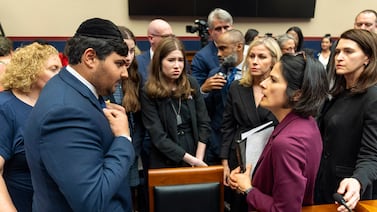Sign up for Chalkbeat Chicago’s free daily newsletter to keep up with the latest education news.
Illinois lawmakers and education advocates say Gov. J.B. Pritzker’s proposed budget does not recommend enough money for schools to help newly arrived migrant students.
Pritzker’s budget proposal in February did not include an additional $35 million to support migrant students that the Illinois State Board of Education had requested in the budget proposal it submitted in January.
State Rep. Fred Crespo, a Democrat representing suburbs northwest of Chicago, has filed a pair of bills — House Bill 2822 and House Bill 3991— that would allow the Illinois State Board of Education to create a $35 million New Arrival Grant program that would distribute funding to school districts to support migrant students.
Crespo said he plans to amend the legislation to request $150 million for the grant program.
Both bills are currently in committees in the House.
A spokesperson for Pritzker said in a statement to Chalkbeat that the governor’s priority is to ensure newly arrived migrant families have shelter, food, and a path to independence. The governor and Cook County officials pledged $250 million for shelter, health care, and wraparound services in February
“Schools are also able to access federal funding for many new arrived students under the federal McKinney Vento law to support homeless services,” said the governor’s office. “The Governor also proposed a $350 million increase in K-12 funding and new students will be incorporated into funding formulas at their districts moving forward.”
Since 2017, Illinois has distributed funding to K-12 public schools through a formula that takes into account need, such as how many low-income students, English language learners, or students with disabilities are enrolled.
Erika Méndez, director of P-12 education policy and advocacy at the Latino Policy Forum, said the state’s evidence-based funding formula to fund K-12 public schools is not enough to keep up with the number of migrant students entering and leaving school districts.
“When you’re thinking about funding distribution, they use enrollment data which doesn’t capture all of the transiency that happens in a school year when you’re receiving newcomers or they’re leaving your school districts,” said Méndez.
Méndez said migrant families are resettling in communities around the state and schools need money to reduce class sizes, address staffing shortages, and fix infrastructure of schools.
Chicago Public Schools has said it does not collect information on the immigration status of students. But overall enrollment in the district has climbed since the start of the school year and nearly 7,000 more students have been identified as English language learners, according to a Chalkbeat analysis of mid-year enrollment data from the district. English language learners are not all new arrivals.
School districts across the state have also seen an increase in English language learner enrollment over the last five years, moving from 12.1% of the state’s total enrollment in 2019 to 14.6% in 2023, according to the state report card. In October, state officials said they could not say how many students are migrants from Latin America or refugee students from Ukraine or Afghanistan.
Teachers have said schools need more support to help students who are in need of housing, clothing, and food, as well as more staff who can speak Spanish.
The City of Chicago has reported over 37,000 asylum-seekers have arrived in the city as of March 14, 2024. The city’s dashboard doesn’t specify how many of those new arrivals are of school age.
Ralph Martire, executive director of the Center for Tax and Budget Accountability and one of the architects of the state’s evidence-based funding formula, said the funding formula will adjust for the needs of the school based on the schools overall enrollment and the enrollment of students from low-income households, English learners, and students with disabilities. But it depends on the tier of the school.
Tiers determine the level of need for state funding. School districts that fall in Tier 1 or 2 are higher on the priority list for state funding and receive more funding, while Tiers 3 and 4 receive a smaller amount of state dollars.
“CPS schools are in Tier 2,” said Martire. “They are not going to get the full benefit of the support of the enhanced investment that a Tier 1 district would get.”
Chicago Public Schools moved down from Tier 1 to Tier 2 in 2022 after the district saw a loss of low-income students but an increase in property tax base. In 2022 and 2023, the district saw slightly less new money from the state. Since the change in tiers, CPS officials have raised concerns about the decrease in state funding and what it means for the district.
District officials recently said in a statement to Chalkbeat that they appreciate the governor’s continued commitment to put new money into the state’s evidence-based funding formula, but the model has fallen short, leaving CPS about $1.1 billion short of its “adequacy target.”
A report from the Center of Tax and Budget accountability found last year that the evidence-based funding formula is working to reduce funding gaps between wealthier and underfunded districts and increase funding for districts serving more students of color and those from low-income families.
The state’s final budget won’t be finalized until the end of the spring legislative session in late May.
Samantha Smylie is the state education reporter for Chalkbeat Chicago, covering school districts across the state, legislation, special education, and the state board of education. Contact Samantha at ssmylie@chalkbeat.org.






